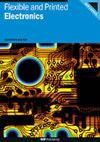基于丝网印刷聚对二甲苯/聚氨酯复合材料的低压范围柔性电容和压阻压力传感器
IF 3.2
4区 工程技术
Q3 MATERIALS SCIENCE, MULTIDISCIPLINARY
引用次数: 0
摘要
摘要:利用聚合物制造柔性压力传感器替代传统压力传感器,促进了人体生理监测和电子皮肤的发展。特别是,利用各种材料制造柔性电容式和压阻式传感器及其机电性能的研究是这些领域的进一步发展。本文采用化学气相沉积法合成了聚对二甲苯。压敏油墨是由聚对二甲苯、聚氨酯、聚甲基丙烯酸甲酯和活性炭按一定的重量比混合而成的。柔性电容式和压阻式压力传感器是用丝网印刷方法制造的。灵敏度、检出限、线性范围和响应/弛豫时间决定了电容性和压阻性。在0.07 ~ 1.39 kPa的压力范围内,柔性电容式和压阻式压力传感器的灵敏度分别为0.124 kPa−1和0.074 kPa−1。该研究使聚对二甲苯C能够用于复合材料结构,并表明它不仅可以用作保护层,还可以用于柔性压力传感器。这也保证了柔性电容式压力传感器的设计与柔性压阻式压力传感器相比,能够以高灵敏度测量低压。本文章由计算机程序翻译,如有差异,请以英文原文为准。
Flexible capacitive and piezoresistive pressure sensors based on screen-printed parylene C/polyurethane composites in low-pressure range
Abstract The use of polymers to fabricate flexible pressure sensors as an alternative to conventional pressure sensors has led to the development of physiological monitoring of human body and the electronic skin. In particular, the fabrication of flexible capacitive and piezoresistive sensors using a variety of materials and the investigation of their electromechanical properties are further developments in these fields. Herein, parylene C is synthesized via chemical vapor deposition method. Pressure-sensitive inks are prepared with a composite of parylene C, polyurethane, polymethylmethacrylate, and activated carbon at certain weight ratios. Flexible capacitive and piezoresistive pressure sensors are fabricated by the screen printing method. The sensitivity, detection limit, linearity range, and response/relaxation time, which define the capacitive and piezoresistive properties are investigated and presented in this paper. The sensitivities of the flexible capacitive and piezoresistive pressure sensors are 0.124 kPa −1 and 0.074 kPa −1 in the pressure range of 0.07–1.39 kPa. This study enables parylene C to be used in the composite structure and shows that it can be used not only as a protective layer but also in flexible pressure sensor applications. It also ensures that the design of the flexible capacitance pressure sensor can measure low pressure with high sensitivity compared to the flexible piezoresistive pressure sensor.
求助全文
通过发布文献求助,成功后即可免费获取论文全文。
去求助
来源期刊

Flexible and Printed Electronics
MATERIALS SCIENCE, MULTIDISCIPLINARY-
CiteScore
4.80
自引率
9.70%
发文量
101
期刊介绍:
Flexible and Printed Electronics is a multidisciplinary journal publishing cutting edge research articles on electronics that can be either flexible, plastic, stretchable, conformable or printed. Research related to electronic materials, manufacturing techniques, components or systems which meets any one (or more) of the above criteria is suitable for publication in the journal. Subjects included in the journal range from flexible materials and printing techniques, design or modelling of electrical systems and components, advanced fabrication methods and bioelectronics, to the properties of devices and end user applications.
 求助内容:
求助内容: 应助结果提醒方式:
应助结果提醒方式:


